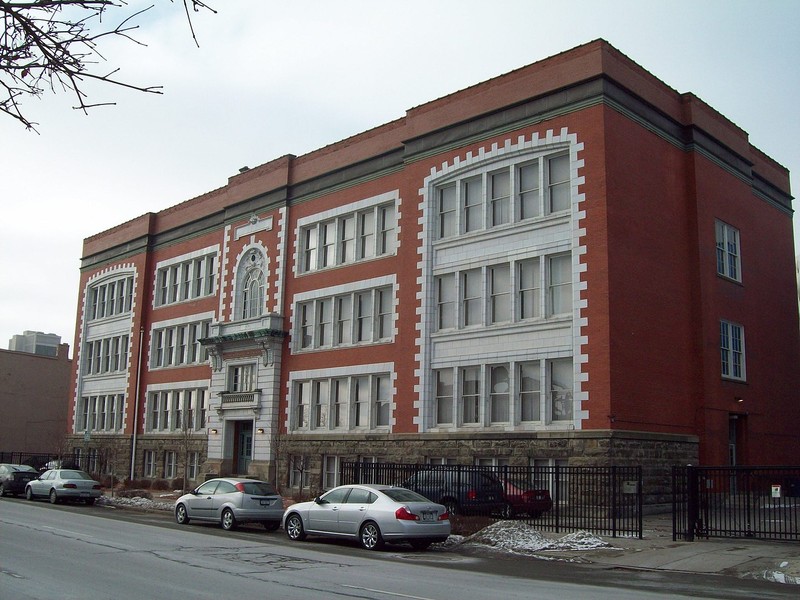School 13
Introduction
Text-to-speech Audio
Images
Buffalo School #13 pictured in 2009.

Backstory and Context
Text-to-speech Audio
School 13, which opened in 1915, operated as an early twentieth-century urban primary school serving numerous immigrant children from the mid-nineteenth century into the World War era. Many of the kids came from very poor neighborhoods and some even held jobs while also attending school. By the 1930s, the school changed from a mixed-gender institution to an all-boys format. Shifts during the 1950s - 1970s consisted of the school changing from a mainstream school to one educating kids with disciplinary problems followed by those with disabilities. By 1975, the school held the name Boys Alternative School, a name that stood until the school closed in 2003. The historic building opened in 1915 with a Neo-Classic design correlated with the early twentieth century's broader Beau-Arts trend.
Buffalo's growth received a significant boost when the Erie Canal opened in 1825 and the city served as its western terminus. Buffalo stood as the Great Lakes region's shipbuilding capital by 1830 and a bustling hub serving water traffic from New York to the east and places like Cleveland and Detroit, and a rapidly growing Chicago to the West. By 1843, the railways arrived, furthering the city's expansion and increasing its industrial presence, as well. Buffalo stood as the nation's eighth-largest city in 1900, gaining the nickname "Queen City of the Lakes."
The rapid growth, industrial expansion, shipping businesses, and related factors led to a population boom that included an abundance of immigrants. By 1900, nearly three-quarters of the entire city population were immigrants. As a result of the soaring population, a necessity arose for developing civic services ranging from housing and transpiration to sanitation and sewage to recreation and education, which included schools and libraries. School 13 sits in one of the fifteen original school districts created by the Buffalo Board of Education in 1838. The first School 13 building served students from 1838 to the mid-1850s. The second schoolhouse opened just before the Civil War and underwent a renovation and addition project during the 1890s. Finally, in 1911, the proposal emerged for the much larger, highly-planned (and now-historic) School 13 building that opened in 1915. Most of the students who attended School 13 were from immigrant families such as first and second-generation Germans (the majority), Italians, Poles, Hungarians, Swiss, and many more. In fact, the school's principal during the 1920s suggested to a local paper that pupils from more than twenty-five nations attended the school. Many of the kids attending Buffalo public schools also worked at various jobs such as canning factories or as "newsies," who sold papers on the street.
Unlike its two forerunners, the 1915 structure included intricate and ornate designs along with modern engineering. The three-story red brick and white glazed terra cotta school displayed a handsome Neo-Classic facade and numerous features in line with the Beaux-Arts tradition that dominated American architecture from roughly 1880-1930. Engineering features included fireproofing features, including the steel framing and large windows born of the Chicago School of Architecture. The 1915 building reflected Progressive-Era ideals about the strong connection between mind and body. Students ranging from kindergarten to ninth grade learned reading, writing, math, and both vocational skills and economics. The building also housed a domestic science department, a large auditorium, and physical education facilities that included a pool. The school dually served as a community center, including opening up its physical education facilities to the public in off-school hours. In short, a belief emerged by reformers that a healthy school and community center would appease immigrants, workers (read: the poor) as to avoid any civic unrest resulting labor or social strife.
In 1932 the school transitioned to an all-boys establishment (ages four to seventeen) known as the Boys' Continuation School. After World War II, the school became Boys High School, and then by the 1960s, the school primarily catered to troubled kids and changed its name to Boys Adjustment School. By the 1970s, the school mainly attended to students with learning disabilities and mental challenges, thus evolving again in 1975 to Buffalo Alternative High School, which remained its name until it closed in 2003.
Today, the building operates as an apartment complex. Still, it stands as a memento of a time when Buffalo existed as a bustling industrial center around the turn of the century. Moreover, it provides a physical reminder of an era when the nation urbanized. Northeast and Great Lakes cities rapidly grew in association with the development of canals, railways, and factories. People came to cities looking for jobs, including those from foreign lands. As a result, cities also provided services to support the growing population, including schools and community centers such as School 13.
Sources
Goldman, Mark. City on the Edge: Buffalo, New York, 1900 - Present. Amherst, NY: Prometheus Publishing, 2007.
Ross, Claire L. "Nomination Form: School 13." National Register of Historic Places Registration. archive.gov. January, 2004. https://catalog.archives.gov/id/75317699
Seller, Maxine, "The Education of Immigrant Children in Buffalo, New York 1890–1916." New York History 57, no. 2 (1976): 183-99. http://www.jstor.org/stable/23169322.
By Pubdog (talk) - I (Pubdog (talk)) created this work entirely by myself.Transferred from en.wikipedia, Public Domain, https://commons.wikimedia.org/w/index.php?curid=16989496
